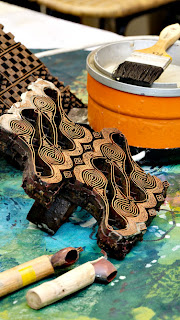Els Van Baarle's beautifully textured art has been drawing attention, awards, and critical acclaim for decades. Using dyes, paint, resists, and silkscreens, she has created a distinctive, nuanced style which is all her own. During her recent Soy Batik workshop at ProChem in Massachusetts, she talked about her work:
How would you describe your work?
Mixed media- I make textiles, mostly whole cloth. I like to work in layers- layers of wax and dye, sometimes I add paper. Or I work only on paper, with wax and dye.
My pieces often have three layers in order to meet the criteria for a "quilt" in juried competitions and exhibits; showing in these venues gives me more opportunities to sell my work. I like showing work at the Surface Design Association show/conference due to its minimal criteria regarding layers, construction, etc.
When exhibiting with painters and their framed pieces, I often stretch large pieces over a frame; I've found this works well. Wholecloth free-form pieces are sometimes not as appealing when shown alongside framed works.
What is your art background?
I started as a textile instructor teaching drawing as well as training people to be teachers of children. I love teaching and love to work with my colleagues. There is much interest in learning and so many techniques and media; its overall effect has been less focus on specific basic skills such as sewing and quilting which are so important. Young artists have less patience- often wanting to start with a beautiful finished result without learning the basics and taking time to understand the process.
In the Netherlands, the government sets standards for school study. (There are very few private schools.) Thirty years ago, there was a good block of time dedicated to art study in elementary schools. Then 15 years ago the system was changed; blocks of money were given to schools to spend as they wished. Many schools put the money into computers/technology and teaching jobs were lost. Then recently, parents complained about the lack of gym, music and art studies and these programs now are being reincorporated again.
How has your work changed over the years?
It's more loose now. I use colors that embody the theme of the series: browns, blacks, muddy colors and turquoise with muddy tones are some of my favorites. I mix colors- I never use dyes straight from the containers.
 |
| Nothing is the Same I & II |
What are some of your past exhibit venues?
In 2007, I exhibited my work at Fort Rammekens in Ritthem, Zeeland, the Netherlands. It is the oldest coastal fort in Western Europe. The rooms are worn and decayed; the walls are crumbling and contain ancient marks and writings. It was an intriguing venue in which to display my work.
I had previously met artist Jeanne Beck in 2005-2006 in the U.S. When I was telling her about the coming exhibition at the Fort, I was so excited about it, Jeanne followed us (4 Dutch artists) while we were working on the 2007 exhibit and then wrote about it for the SDA Journal. This wonderful experience led to another great opportunity: collaborating with artists on the Art Cloth group exhibit.
Currently, my work is included in a touring group exhibit entitled Art Cloth: Engaging New Visions. Other exhibiting artists include Jeanne Beck and Jane Dunnewold. It is currectly in Australia and will come to the U.S. in 2011.
Past venues for my work include the Columbus Museum of Art, World Batik conference in Boston, Thirty Moons Gallery in Sante Fe, NM and Quilt Festival in England.
 |
| Hieronder Rust (translation: under this stone is resting) |
 |
| Hieronder Rust (detail) |
What inspires your work?
Antiquity, worn structures and the colors/ textures they display. I've made several pieces from gravestone rubbings. Hieronder Rust is a hand-stitched silk rubbing with Pebeo Setacolor paint. On this particular piece, the year was 1672 and the person was 61 years old. On every piece, I embroidered the year the person died and/or their age.
 |
| wax pot, tjaps, tjantings |
What is the most valuable tool in your studio?
My tjaps (pronounced chops) are my most prized tools! I've been collecting them for 30-40 years. Authentic tjaps are from Indonesia, formerly a Dutch possession and many of their items are available in the Netherlands. I look for them in our antique shops.
[writers note: tjaps are copper stamps used to apply wax onto fabric/papers as a resist to subsequent dyeing or discharging. They commonly come from Indonesia or Java where the batik process originated.]
What do you miss most when you are traveling?
First, my dogs!! Then, I miss creating in my studio. Teaching, traveling, and seeing others creating art puts my individual work on hold so I'm now eager to get back to my studio work!
______________________________________
Els' works Nothing is the Same I & II are in the touring exhibit entitled Art Cloth: Engaging New Visions curated by Marie-Therese Wisniowski. In this group exhibit, each artist was asked to provide an Art Cloth piece approximately 1 metre X 3 metre. For a complete list of artists and details about the exhibit visit:
http://www.artclothstudios.com/exhibitions.php/
Els' work has been exhibited at prestigious venues in the U.S., Great Britain, France, Italy, Poland, Germany, Hungary, Korea, and Lithuania. Her work has earned awards at numerous Quilt Surface Design Symposiums as well as other textile exhibits/conferences and has been published in the Surface Design Journal, Quilting Arts and Fiber Arts magazines, Textil kunst, and Textil Forum. She lives in the Netherlands.
Her website is http://www.elsvanbaarle.com/
For a look inside Els' batik class, visit: http://blogsfromthecave.blogspot.com/




No comments:
Post a Comment